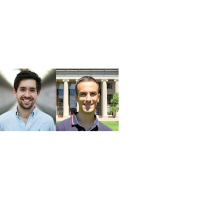Boltz: Towards a Unified Approach for Biomolecular Interaction Modeling

Speaker
Host
7:00 PM, Tuesday, 24 June 2025
MIT Room 32-G449 (Kiva) and online via Zoom
Boltz: Towards a Unified Approach for Biomolecular Interaction Modeling
[With updates on new features in Boltz-2 including the ability to predict Binding Affinity]
Gabriele Corso and Jeremy Wohlwend
Please register in advance for this seminar even if you plan to attend in person at https://acm-org.zoom.us/webinar/register/3917463193515/WN_U1yhFblMQO-I4n1cBhkBFw
After registering, you will receive a confirmation email containing information about joining the webinar.
Indicate on the registration form if you plan to attend in person. This will help us determine whether the room is close to reaching capacity. We plan to serve light refreshments (probably pizza) before the talk starting at around 6:30 pm. Letting us know you will come in person will help us determine how much pizza to order.
We may make some auxiliary material such as slides and access to the recording available after the seminar to people who have registered.
Abstract:
Accurately modeling biomolecular interactions is a central challenge in modern biology. While recent advances, such as AlphaFold3 and Boltz-1, have substantially improved our ability to predict biomolecular complex structures, these models still fall short in
predicting binding affinity, a critical property underlying molecular function and therapeutic efficacy. In this talk, we present Boltz-2, a new structural biology foundation model that exhibits strong performance for both structure and affinity prediction. Boltz-2
introduces controllability features including experimental method conditioning, distance constraints, and multi-chain template integration for structure prediction, and is, to our knowledge, the first AI model to approach the performance of free-energy perturbation (FEP) methods in estimating small molecule--protein binding affinity. Crucially, it achieves strong correlation with experimental readouts on many benchmarks, while being at least 1000 times more computationally efficient than FEP.
For more information see boltz-2 info
Bio:
Jeremy Wohlwend and Gabriele Corso received PhDs this spring for work at the MIT Computer Science and Artificial Intelligence Laboratory where their research focuses on developing novel ML frameworks to tackle challenging problems in drug discovery and immunology.
Directions to 32-G449 - MIT Stata Center, 32 Vassar Street, Cambridge, MA: Please use the main entrance to the Stata Center at 32 Vassar Street (the entrance closest to Main street) as those doors will be
unlocked. Upon entering, proceed to the elevators which will be on the right after passing a large set of stairs and a MITAC kiosk. Take the elevator to the 4th floor and turn right, following the hall to an open area; 32-G449 will be on the left. Location of Stata on campus map.
This joint meeting of the Boston Chapter of the IEEE Computer and EMBS Societies and GBC/ACM will be hybrid (in person and online).
Up-to-date information about this and other talks is available online at http://ewh.ieee.org/r1/boston/computer/. You can sign up to receive updated status information about this talk and informational emails about future talks at http://mailman.mit.edu/mailman/listinfo/ieee-cs,
our self-administered mailing list.